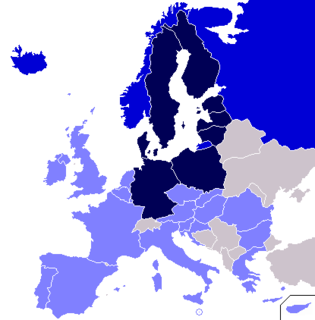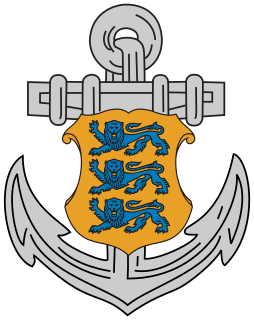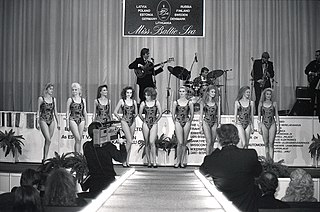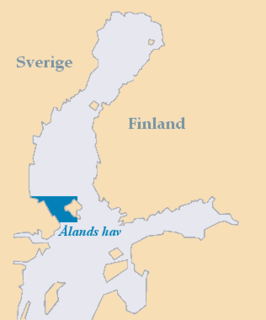| Miss Baltic Sea 1991 | |
|---|---|
| Date | December 17, 1990 |
| Entrants | 9 |
| Placements | 3 |
| Winner | Nina Andersson |
Miss Baltic Sea 1991 is the first annual Miss Baltic Sea. Countries from the Baltic Sea has competed a pageant and only 9 contestants. Miss Finland has won.
| Miss Baltic Sea 1991 | |
|---|---|
| Date | December 17, 1990 |
| Entrants | 9 |
| Placements | 3 |
| Winner | Nina Andersson |
Miss Baltic Sea 1991 is the first annual Miss Baltic Sea. Countries from the Baltic Sea has competed a pageant and only 9 contestants. Miss Finland has won.
| Final results | Contestant |
|---|---|
| Miss Baltic Sea 1991 |
|
| 1st runner-up | |
| 2nd runner-up |
|

The Baltic Sea is an arm of the Atlantic Ocean, enclosed by Denmark, Estonia, Finland, Germany, Latvia, Lithuania, Sweden, Poland, Russia and the North and Central European Plain.

The Gulf of Finland is the easternmost arm of the Baltic Sea. It extends between Finland to the north and Estonia to the south, to Saint Petersburg in Russia to the east, where the river Neva drains into it. Other major cities around the gulf include Helsinki and Tallinn. The eastern parts of the Gulf of Finland belong to Russia, and some of Russia's most important oil harbours are located farthest in, near Saint Petersburg. As the seaway to Saint Petersburg, the Gulf of Finland has been and continues to be of considerable strategic importance to Russia. Some of the environmental problems affecting the Baltic Sea are at their most pronounced in the shallow gulf.

Lake Ladoga is a freshwater lake located in the Republic of Karelia and Leningrad Oblast in northwestern Russia, in the vicinity of Saint Petersburg.

The Council of the Baltic Sea States (CBSS) is a regional intergovernmental organisation working on three priority areas: Regional Identity, Safe & Secure Region and Sustainable & Prosperous Region. These three priority areas aim to address the themes of environment, economic development, entrepreneurship, education, culture, civil security, children's rights and trafficking in human beings.

The Nordic Council is the official body for formal inter-parliamentary Nordic cooperation among the Nordic countries. Formed in 1952, it has 87 representatives from Denmark, Finland, Iceland, Norway, and Sweden as well as from the autonomous areas of the Faroe Islands, Greenland, and the Åland Islands. The representatives are members of parliament in their respective countries or areas and are elected by those parliaments. The Council holds ordinary sessions each year in October/November and usually one extra session per year with a specific theme. The council's official languages are Danish, Finnish, Icelandic, Norwegian, and Swedish, though it uses only the mutually intelligible Scandinavian languages—Danish, Norwegian, and Swedish—as its working languages. These three comprise the first language of around 80% of the region's population and are learned as a second or foreign language by the remaining 20%.

The Gulf of Bothnia is the northernmost arm of the Baltic Sea. It is situated between Finland's west coast (Ostrobothnia) and Sweden's east coast. In the south of the gulf lie the Åland Islands, between the Sea of Åland and the Archipelago Sea.

The Baltic states, also known as the Baltic countries, Baltic republics, Baltic nations, or simply the Baltics, is a geopolitical term, typically used to group the three sovereign states on the eastern coast of the Baltic Sea: Estonia, Latvia, and Lithuania. The term is not used in the context of cultural areas, national identity, or language, because while the majority of people in Latvia and Lithuania are Baltic people, the majority in Estonia are Finnic. The three countries do not form an official union, but engage in intergovernmental and parliamentary cooperation. The most important areas of cooperation among the three countries are foreign and security policy, defence, energy, and transportation.

The terms Baltic Sea Region, Baltic Rim countries, and the Baltic Sea countries/states refer to slightly different combinations of countries in the general area surrounding the Baltic Sea in Northern Europe.

The Archipelago Sea is a part of the Baltic Sea between the Gulf of Bothnia, the Gulf of Finland and the Sea of Åland, within Finnish territorial waters. By some definitions it contains the largest archipelago in the world by the number of islands, although many of the islands are very small and tightly clustered.

The Baltic Sea Campaigns were conducted by Axis and Allied naval forces in the Baltic Sea, its coastal regions, and the Gulf of Finland during World War II. After early fighting between Polish and German forces, the main combatants were Germany and Finland, opposed by the Soviet Union. Sweden's navy and merchant fleet played important roles, and the British Royal Navy planned Operation Catherine for the control of the Baltic Sea and its exit choke point into the North Sea.

The Estonian Navy are the unified naval forces among the Estonian Defence Forces.

The Baltic Ice Lake is a name given by geologists to a freshwater lake that evolved in the Baltic Sea basin as glaciers retreated from that region at the end of the last ice age. The lake existed between 12,600 and 10,300 years Before Present (BP).
Miss Scandinavia was a beauty pageant for Nordic females. The contest was merged with the Miss Baltic Sea pageant for the years 2007 and 2008 and after that the merged pageant was also discontinued.

Miss Baltic Sea was a beauty pageant for countries that border the Baltic Sea: Denmark, Estonia, Finland, Germany, Latvia, Lithuania, Poland, Russia and Sweden. It merged with Miss Scandinavia for the years 2007 and 2008 and then that merged pageant was discontinued.

The Bothnian Bay or Bay of Bothnia is the northernmost part of the Gulf of Bothnia, which is in turn the northern part of the Baltic Sea. The land holding the bay is still rising after the weight of ice-age glaciers has been removed, and within 2,000 years the bay will be a large freshwater lake. The bay today is fed by several large rivers, and is relatively unaffected by tides, so has low salinity. It freezes each year for up to six months. Compared to other parts of the Baltic it has little plant or animal life.

Karita Tykkä is a Finnish television host, actress and model. She won the Miss Finland beauty pageant in 1997 and the Miss Baltic Sea pageant in 1998. In 2001, she made her debut as an actress in the comedy film Ponterosa.

The Sea of Åland is a waterway in the southern Gulf of Bothnia, between the Åland islands and Sweden. It connects the Bothnian Sea with the Baltic Sea proper. The seas are often choppy here. The narrowest part is named South Kvarken. The trench running on the bottom of the Sea of Åland contains the second-deepest spot of the Baltic Sea, at a depth of 301 meters, which is second only to Landsort Deep.

The Baltic Finnic peoples, Baltic Sea Finns, Baltic Finns, sometimes also Western Finns, often simply referred to as the Finnic peoples, are Finno-Ugric peoples inhabiting the Baltic Sea region in Northern and Eastern Europe who speak Finnic languages, including the Finns proper, Estonians, Karelians, Veps, Izhorians, Votes, and Livonians, as well as their descendants worldwide. In some cases the Kvens, Ingrians, Tornedalians and speakers of Meänkieli are also included separately rather than as a part of Finns proper.

The Soviet occupation of the Baltic states covers the period from the Soviet–Baltic mutual assistance pacts in 1939, to their invasion and annexation in 1940, to the mass deportations of 1941.

Finland–Latvia relations are foreign relations between Finland and Latvia. Finland has an embassy in Riga. Latvia has an embassy in Helsinki. Both countries are full members of the Council of the Baltic Sea States, the European Union and the Eurozone.